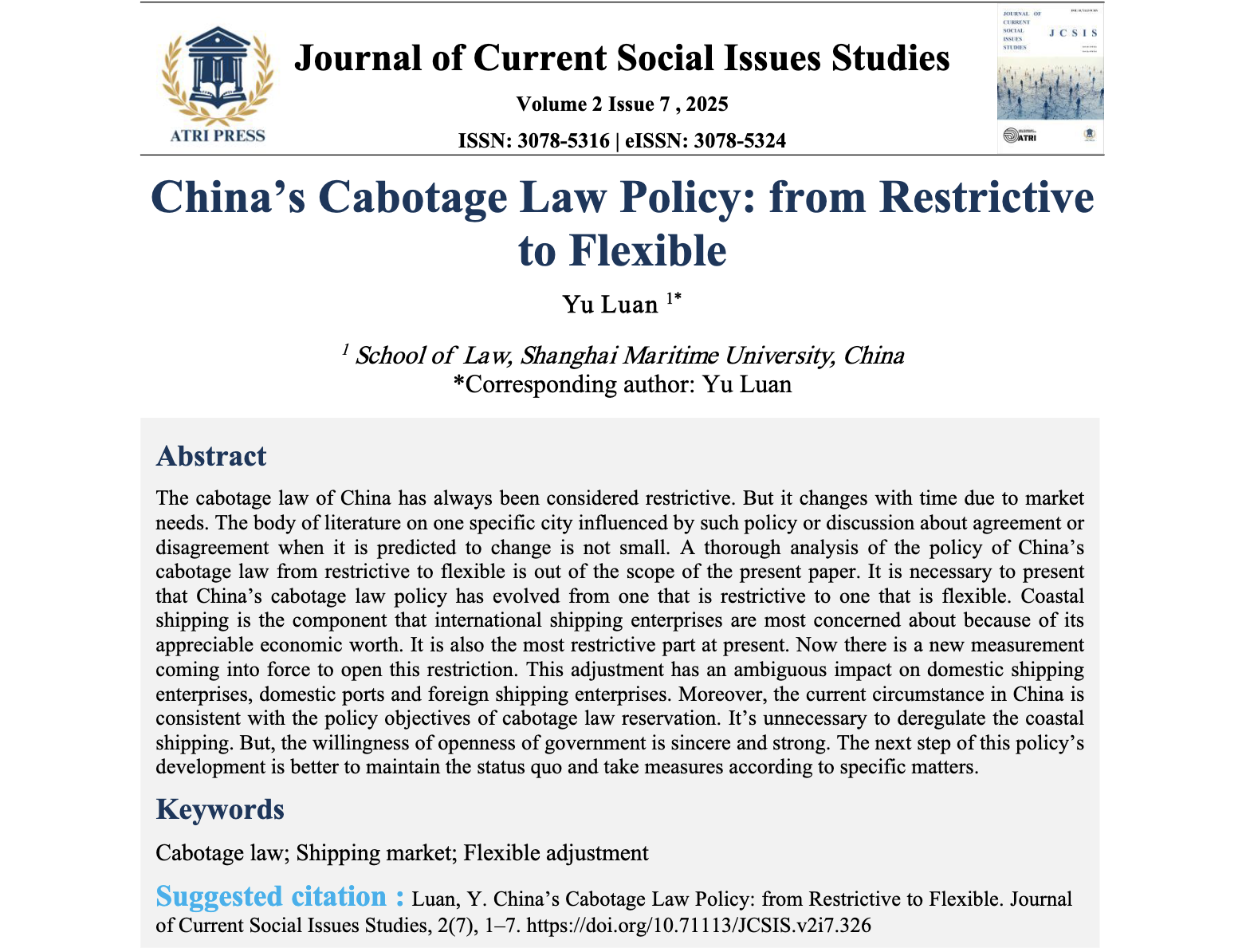China’s Cabotage Law Policy: from Restrictive to Flexible
DOI:
https://doi.org/10.71113/JCSIS.v2i7.326Keywords:
Cabotage law, Shipping market, Flexible adjustmentAbstract
The cabotage law of China has always been considered restrictive. But it changes with time due to market needs. The body of literature on one specific city influenced by such policy or discussion about agreement or disagreement when it is predicted to change is not small. A thorough analysis of the policy of China’s cabotage law from restrictive to flexible is out of the scope of the present paper. It is necessary to present that China’s cabotage law policy has evolved from one that is restrictive to one that is flexible. Coastal shipping is the component that international shipping enterprises are most concerned about because of its appreciable economic worth. It is also the most restrictive part at present. Now there is a new measurement coming into force to open this restriction. This adjustment has an ambiguous impact on domestic shipping enterprises, domestic ports and foreign shipping enterprises. Moreover, the current circumstance in China is consistent with the policy objectives of cabotage law reservation. It’s unnecessary to deregulate the coastal shipping. But, the willingness of openness of government is sincere and strong. The next step of this policy’s development is better to maintain the status quo and take measures according to specific matters.
Downloads
References
[1] Robert Y. Cavana."A qualitative analysis of reintroducing cabotage onto New Zealand's coasts." Maritime Policy & Management 31.3(2004): doi:10.1080/0308883042000209544.
[2]H.U."China set to become a strong, modernized maritime country in the middle of next century." Containerization .08(1998):31-32. doi:
[3]Daojun Wang." Maersk hope Free Trade Zone open up“coastal piggyback for foreign ships”." Pearl River Water Transport .10(2015):33. doi:10.14125/j.cnki.zjsy.2015.10.020.
[4]Chunhui Lin, Yifan Liao."“On the policy motion of "carrying heavy containers along the coast" of international liner (first part)." Shipping Management .08(2004):8-10. doi:
[5]Chunhui Lin, Yifan Liao."“On the policy motion of "carrying heavy containers along the coast" of international liner (second part)." Shipping Management .09(2004):26-29. doi:
[6]Shanchun Ye."Research of Coastal Container Transshipment Development in Free Trade Zone." Value Engineering 36.36(2017):226-227. doi:10.14018/j.cnki.cn13-1085/n.2017.36.098.
[7]Yi Ding, Chaode Liu, and Guolong Lin."An Optimizing Model of Hub-and-spoke Shipping Network Considering Maritime Cabotage." Chinese Journal of Management Science 23.S1(2015):830-835. doi:
[8]W. H. Wong, et al."Impact of cabotage relaxation in mainland China on the transshipment hub of Hong Kong." Maritime Economics & Logistics 21.4(2019): doi:10.1057/s41278-018-0112-1.
[9]Mengyu You."First time to open the domestic waterway transport and water construction market to foreign ships in Hainan province "Hainan Daily 2021-06-29,A04,Hainan province news Comprehensiveness.
[10]Aniekan Akpan.Maritime Cabotage Law.Taylor and Francis,2018,pp.17-18.
[11]Administrative regulations see interim adjustments at Lingang special area, Nov 18,2021 available at http://english.www.gov.cn/policies/latestreleases/202111/18/content_WS61962854c6d0df57f98e5233.html
[12] Regulation on International Ships in the Hainan Free Trade Port [N]. Hainan Daily,2021-06-27(A06).DOI:10.28356/n.cnki.nhlrb.2021.004850.

Downloads
Published
How to Cite
Issue
Section
License
Copyright (c) 2025 Yu Luan

This work is licensed under a Creative Commons Attribution 4.0 International License.






















